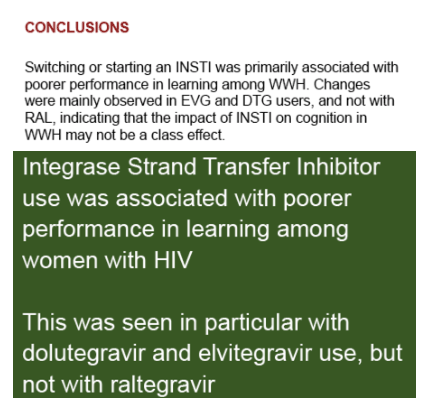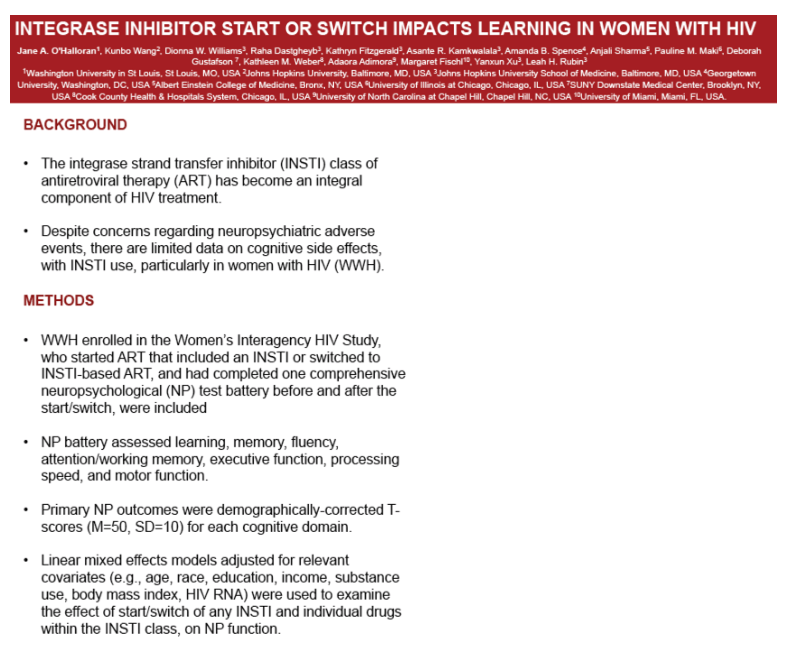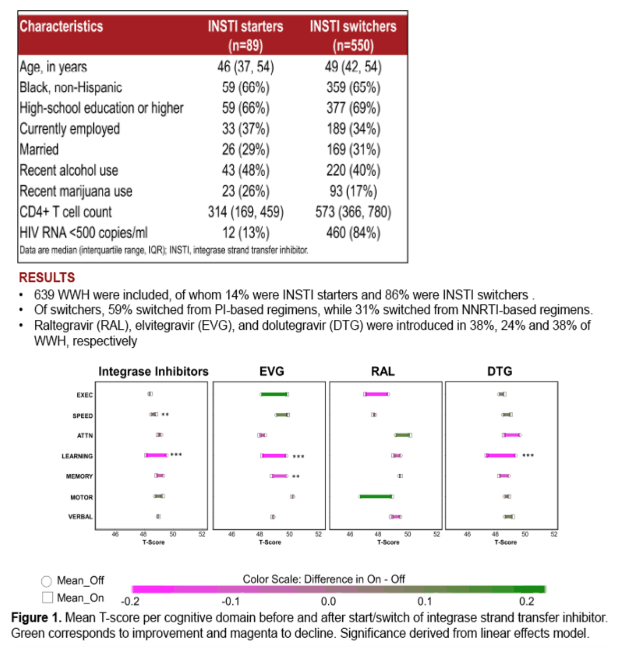 |
 |
 |
| |
INTEGRASE INHIBITOR START OR SWITCH IMPACTS LEARNING IN WOMEN WITH HIV
|
| |
| |
CROI 2020
Reported by Jules Levin
Jane A. O'Halloran1, Kunbo Wang2, Dionna W. Williams3, Raha Dastgheyb3, Kathryn Fitzgerald3, Asante R. Kamkwalala3, Amanda B. Spence4, Anjali Sharma5, Pauline M. Maki<
1Washington University in St Louis, St Louis, MO, USA,2Johns Hopkins University, Baltimore, MD, USA,3Johns Hopkins University School of Medicine, Baltimore, MD, USA,4Georgetown University, Washington, DC, USA,5Albert Einstein College of Medicine, Bronx, NY, USA,6University of Illinois at Chicago, Chicago, IL, USA,7SUNY Downstate Medical Center, Brooklyn, NY, USA,8Cook County Health & Hospitals System, Chicago, IL, USA,9University of North Carolina at Chapel Hill, Chapel Hill, NC, USA,10University of Miami, Miami, FL, USA

Program Abstract
In recent years, the integrase strand transfer inhibitor (INSTI) class of antiretroviral therapy (ART) has become an integral component of HIV treatment. Despite concerns regarding neuropsychiatric adverse events there are limited data on cognitive side effects, particularly in women with HIV (WWH).
WWH enrolled in the Women's Interagency HIV Study (WIHS), who started or switched to INSTI-based ART and had completed one comprehensive neuropsychological (NP) test battery before and after the start/switch, were included. The NP battery assessed learning, memory, fluency, attention/working memory, executive function, processing speed, and motor function. The primary NP outcomes were demographically-corrected T-scores (M=50, SD=10) for each cognitive domain. Linear mixed effects models adjusted for relevant covariates (e.g., age, race, education, income, substance use, body mass index, HIV RNA) were used to examine the effect of start/switch of any INSTI as well as each individual drug within the INSTI class on NP function.
628 WWH, median age 48 (interquartile range 36, 60) years, 65% black non-Hispanic, had NP data before and after INSTI start/switch. While 14% started INSTI-based ART, the remainder switched primarily from protease inhibitor (PI)-based ART (51%) or a non-nucleoside reverse transcriptase inhibitor (NNRTI)-based ART (27%). Raltegravir (RAL), elvitegravir (EVG), and dolutegravir (DTG) were introduced in 38%, 24% and 38% of WWH, respectively.
Overall, any INSTI use was associated with poorer performance in learning after start/switch (p<0.001). Specifically, use of EVG (p=0.02) and DTG (p=0.002), but not RAL, was associated with poorer learning. In analyses restricted to INSTI switch, any INSTI use was associated with poorer performance in learning (p<0.009), as was use of DTG specifically (p=0.004). INSTIs and DTG remained associated with poorer learning among those switching from a PI-based regimen. DTG also remained associated with poorer learning among those switching from an NNRTI (ps<0.05). Switching from an NNRTI to an INSTI was also associated with better processing speed.
Switching or starting an INSTI was primarily associated with poorer performance in learning among WWH. These changes were mainly observed in EVG and DTG users, and not with RAL, indicating that the impact of INSTI on cognition in WWH may not be a class effect.



|
| |
|
 |
 |
|
|